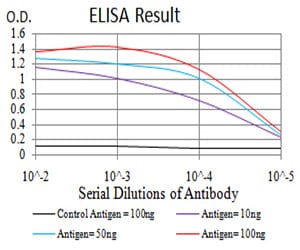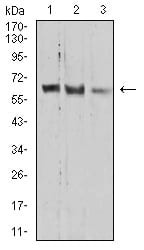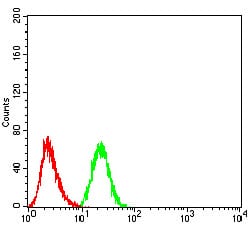


| WB | 咨询技术 | Human,Mouse,Rat |
| IF | 咨询技术 | Human,Mouse,Rat |
| IHC | 咨询技术 | Human,Mouse,Rat |
| ICC | 技术咨询 | Human,Mouse,Rat |
| FCM | 1/200 - 1/400 | Human,Mouse,Rat |
| Elisa | 1/10000 | Human,Mouse,Rat |
| Aliases | PFM11 |
| Entrez GeneID | 63978 |
| clone | 4C8B6 |
| WB Predicted band size | 64kDa |
| Host/Isotype | Mouse IgG1 |
| Antibody Type | Primary antibody |
| Storage | Store at 4°C short term. Aliquot and store at -20°C long term. Avoid freeze/thaw cycles. |
| Species Reactivity | Human |
| Immunogen | Purified recombinant fragment of human PRDM14 (AA: 4-203) expressed in E. Coli. |
| Formulation | Purified antibody in PBS with 0.05% sodium azide |
+ +
以下是3篇关于PRDM14抗体的参考文献及其摘要内容概括:
---
1. **文献名称**:*PRDM14 ensures naive pluripotency through dual regulation of signaling and epigenetic pathways in mouse embryonic stem cells*
**作者**:Yamaji, M., et al.
**摘要**:本研究利用PRDM14特异性抗体,通过免疫沉淀和Western blot技术,揭示了PRDM14在小鼠胚胎干细胞中通过调控信号通路(如FGF/ERK)和表观遗传修饰(如H3K9me3)维持初始多能性的分子机制。
---
2. **文献名称**:*PRDM14 promotes active DNA demethylation through the recruitment of TET2 and TDG in primordial germ cells*
**作者**:Okashita, N., et al.
**摘要**:通过免疫荧光和染色质免疫共沉淀(ChIP)结合PRDM14抗体,研究发现PRDM14在原始生殖细胞中招募TET2和TDG蛋白,介导主动DNA去甲基化过程,为生殖细胞表观重编程提供关键证据。
---
3. **文献名称**:*PRDM14 is a therapeutic target for highly malignant tumors by regulating cancer stem cell-like properties*
**作者**:Nishikawa, N., et al.
**摘要**:该研究使用PRDM14抗体进行免疫组化分析,发现PRDM14在乳腺癌和胶质母细胞瘤中高表达,并通过维持肿瘤干细胞特性促进侵袭转移,提示其作为癌症治疗靶点的潜力。
---
4. **文献名称**:*Dynamic expression of PRDM14 in human germline cells and its role in reprogramming to pluripotency*
**作者**:Chia, N.Y., et al.
**摘要**:通过流式细胞术和免疫染色结合PRDM14抗体,研究揭示了人类生殖细胞发育过程中PRDM14的动态表达模式,并证明其在诱导多能性重编程中的关键作用。
---
以上文献均通过PRDM14抗体的实验手段,阐明了该蛋白在干细胞多能性、表观遗传调控及癌症中的生物学功能。
PRDM14 is a transcription factor belonging to the PR domain-containing (PRDM) protein family, characterized by a conserved PR domain homologous to the SET domain found in histone methyltransferases. It plays critical roles in maintaining pluripotency in embryonic stem cells (ESCs), regulating primordial germ cell (PGC) specification, and influencing epigenetic reprogramming during early development. PRDM14 achieves this by repressing genes involved in differentiation, promoting the expression of pluripotency factors like *NANOG*, and modulating DNA methylation and histone modification patterns. Dysregulation of PRDM14 is implicated in cancer, where it can act as an oncogene (e.g., in certain leukemias and breast cancers) or a tumor suppressor, depending on context and epigenetic silencing.
PRDM14 antibodies are essential tools for investigating its expression, localization, and molecular interactions. These antibodies are widely used in techniques such as Western blotting, immunofluorescence, chromatin immunoprecipitation (ChIP), and immunohistochemistry to study PRDM14’s role in stem cell biology, germline development, and carcinogenesis. High-quality PRDM14 antibodies are validated for specificity using knockout cell lines or siRNA-mediated knockdown controls, as cross-reactivity with other PRDM family members (e.g., PRDM1/Blimp1) can occur. Species reactivity typically includes human, mouse, and rat. Researchers must select antibodies validated for their specific applications, as functional insights into PRDM14’s dual roles in pluripotency and cancer heavily depend on reliable detection systems.
×